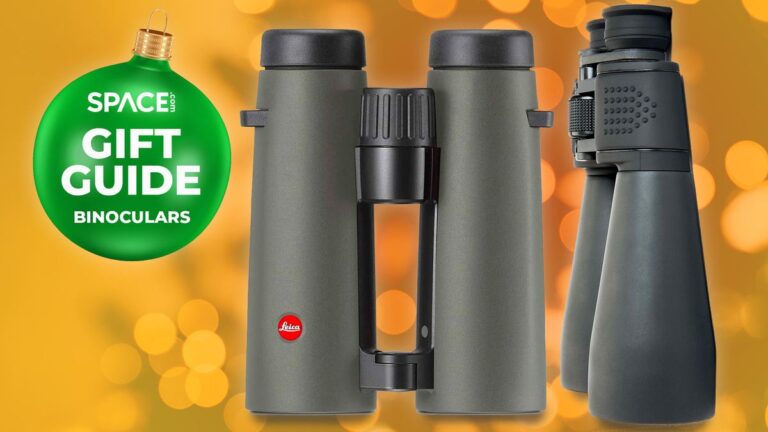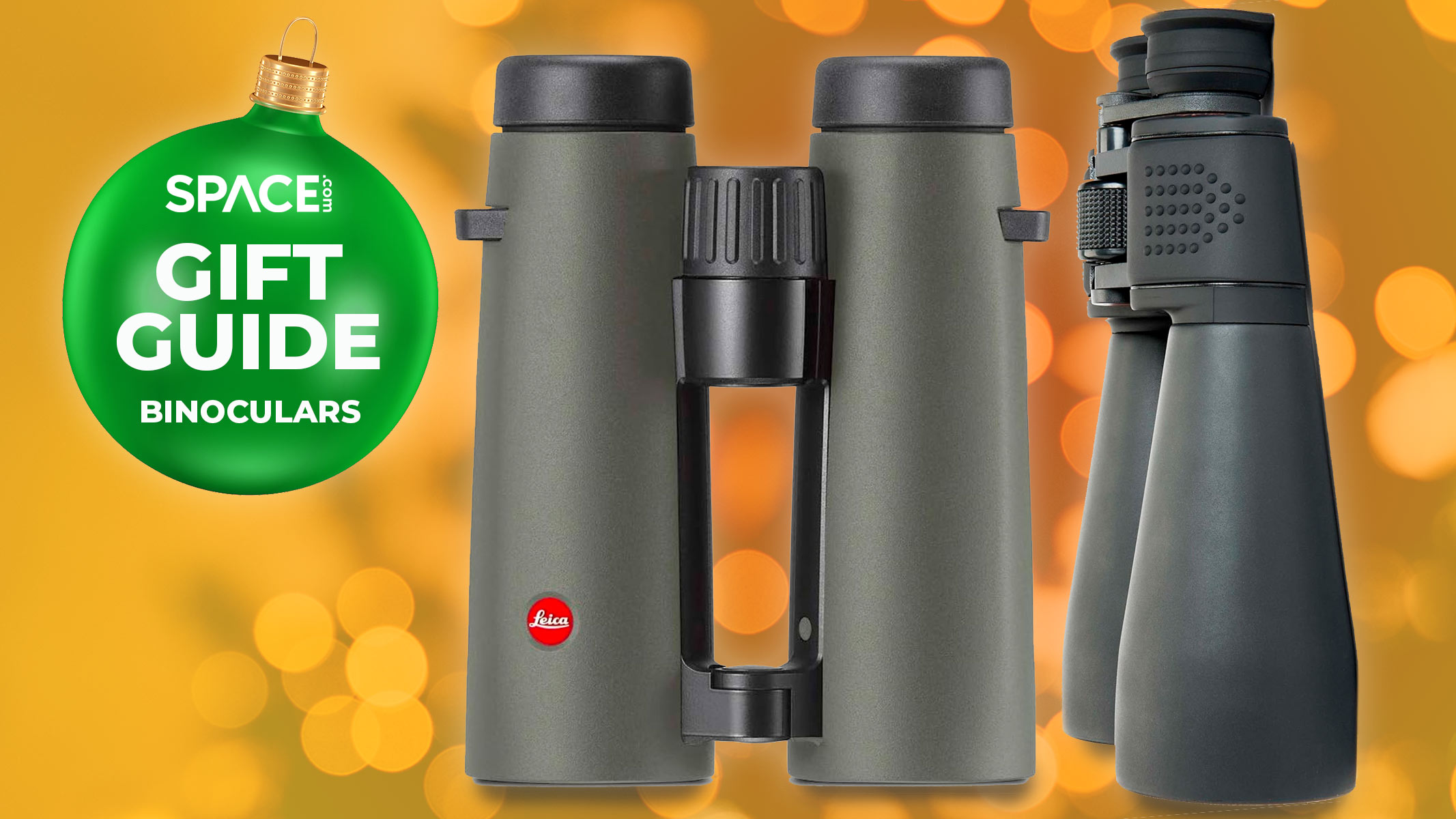
[ad_1]

Binoculars holiday gift guide: Jump menu
Buying astronomical equipment as a gift for a loved one can be a tricky task if you don’t know much about the equipment. Binoculars are a lower-cost alternative to telescopes that can provide hours of enjoyment while stargazing, but how can you tell the good models from the bad ones? Which are the reputable manufacturers, and how do you know the binoculars that you are buying are appropriate for the experience level of their intended user?
This guide aims to ensure that the binoculars you choose meet the requirements of the astronomer in your life; that if they are a beginner then they are easy to use and multi-purpose; that if they are of a more intermediate ability that the binoculars give them that big step up to the next level; and if they are experienced and dedicated observers, that the binocular can meet their demands. You will also want to avoid breaking the bank if at all possible
If you have time to do a bit more research and shopping around, then we recommend that you check out our guide to the best binoculars. On the other hand, if the recipient has an interest in astrophotography, or more detailed planetary observing, then you may find reading our telescope Christmas gift guide useful for finding a more focused astronomical instrument.
Beginner
Binoculars make for simple but very effective stargazing. They are easy to use, can be pointed in any direction without worrying about motorized mounts and if a tree is in the way you can just walk around it with your binoculars. They also have a wide field of view that makes them perfect for just cruising through the Milky Way.
When choosing a binocular for a beginner, there are three things that you need to consider. First and foremost is the quality of the optics, because you want to be able to see enough through the binoculars to hold your interest and maybe spur a life-long interest. The key criteria are the size of the binocular aperture and the amount of magnification. The larger the aperture and the higher the magnification, generally the narrower the field of view, which makes deep-sky objects such as star clusters appear larger when you look through the optical system. The sweet spot is generally regarded as 10×50 (10x magnification, 50mm aperture) but 8×42 is also sufficient to give wide, sweeping views of the stars. Any smaller than this and their use for astronomy is limited.
Related to the quality of the optics is price. Although there are many 10×50 binoculars that are inexpensive, the better quality the lenses, the more you have to pay for them. When buying binoculars for beginners, it is important to balance the amount of money you shell out for them with the quality of the views. Beginners in any hobby are often fickle – you don’t know how long they’re going to stick with the hobby or lose interest. If the latter happens, you don’t want to have spent hundreds of dollars or pounds on an instrument they’re not going to use. But at the same time, you want binoculars that provide the best views possible for the money, so that hopefully they are spellbinding enough to maintain a beginner’s interest long-term.
If their interest begins to wane, then the investment in the binocular might not go to waste if the binocular is multi-purpose, adept at daytime viewing as well as night-time. So, if you’ve got a bird-watcher in your life who also fancies looking at the stars, getting them a binocular that can do both jobs is the optimum choice.
Intermediate
Users of intermediate-level binoculars are often more experienced astronomers who use their binoculars for niche observing — it could be anything from variable and double stars, to star clusters. In which case, the user is usually more demanding of what their binocular can offer them. Such binoculars are designed around night-time use, and although of course they can be used ion the day, they are not particularly optimized for taking on hikes and bird-watching. These binoculars tend to be larger and heavier, which cuts down on how easy it is to walk around with them, and for serious observers who intend to spend a long time with their binoculars, the addition of a tripod with pan-head mount is essential. The optics of such instruments are also more advanced, improving contrast, cutting down on chromatic aberration, and providing bright, crisper views. You should notice a significant improvement over the views through budget telescopes for beginners.
Advanced
Binoculars in the advanced category are often as powerful as telescopes themselves. No longer are you limited to stars and the Moon, but planets start to take shape as real worlds, and far away galaxies become genuine targets for you to pursue. The downside is that these binoculars are heavy, which means investing in a sturdy tripod with a panhandle, or even a counterweighted arm.
You may be wondering why not just buy a telescope? Binoculars, even large heavy ones, still have more of a grab-and-go feel about them over telescopes. Binoculars also have wider fields of view — you can literally feel like you’re floating through the stars. Plus, using two eyes is more comfortable than squinting through one eye at a telescope, and technically with a binocular, you get two telescopes side-by-side, so the field of view is even more extensive.
If you feel that your recipient is ready for a telescope, then be sure to check out our Christmas telescope guide.
Binoculars Holiday gift guide FAQ
Is a binocular a good gift?
A binocular is an excellent gift for all levels and ages of astronomers. Nearly everyone who starts out in astronomy thinks that they must have a telescope. However, humble binoculars are incredibly useful for amateur astronomy and sometimes can even prove more effective than a telescope for viewing some objects.
A binocular is really easy to use and requires very little maintenance. All you need to do is hold them up to your eyes and you are viewing. Also they will give you an image in the correct orientation. Telescopes can either give the observer an inverted image, so the top is at the bottom as well as left and right being reversed; or at least often make the image left and right reversed, which can be confusing. There are good reasons for this and you do get used to it, but binoculars don’t have this potential disadvantage. This then makes them ideal for beginners and younger observers, who may find using a telescope a little too challenging.
What strength of binocular is best?
There are a few things to look out for when you are buying binoculars for skywatching. The most important feature of such instruments is their size. The ideal diameter for the object lenses, the ones nearest to the sky, is 50mm. That is, each lens is 50mm across. Next is the amount of magnification.
You are likely to have come across the numbers 7×50 or 10×50: these tell you that the magnification is either 7x or 10x while the second part of the number, the ’50’, tells you that the aperture of the main lenses are 50mm. If you are buying binoculars mainly for astronomy, do get the best quality you can afford.
It is best not to get binoculars with excessive magnifications. There are several reasons for this. When you increase magnification you will also increase the magnification of your natural hand shake, which can mean that the image is continually dancing around and can make observing challenging, especially if you are trying to study an object in any detail.
Around 10x is therefore the most magnification you should consider, unless you are prepared to tripod mount the instruments. There are occasions where it can be useful to tripod mount even fairly low power binoculars though, such as for extended viewing. With many makes and models it is possible, with the addition of a special bracket, to mount the binoculars onto a photographic tripod. Any binoculars with a magnification of 15x or over will almost certainly need mounting in such a way, as they usually have larger object lenses and are much heavier. If you are buying a tripod to mount your binoculars, do make sure it is very sturdy, as binoculars can be at least as heavy as a modern camera.
Which are more powerful: 10×42 or 10×50?
While these binocular are both able to magnify targets by 10-times, the 10x50s are able to collect more light thanks to their 50mm-diameter objective lenses.
Which is the best binocular to buy?
This largely depends on your budget. However, the quality of the optical system is an essential feature to consider for high-definition, excellent contrast and crystal clear views. You’ll discover two major kinds of binoculars at reputable stockists: the porro-prism and roof-prism. Choose the Porro-prism design for a reliable and affordable piece of kit, making sure that the lenses feature a coating and the glass is of a decent quality (we can vouch for multi-coated optics and BaK4 prisms). If you wear spectacles, we advise choosing binoculars that offer eye relief of at least 14 to 15mm.
Whichever model you decide to go for there are plenty on the market to suit a variety of budgets, observing interests and level of skywatcher. If none of the above take your fancy, then be sure to check out our best binoculars guide.
[ad_2]